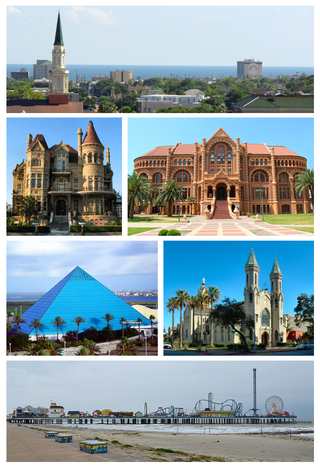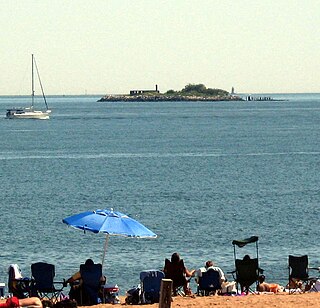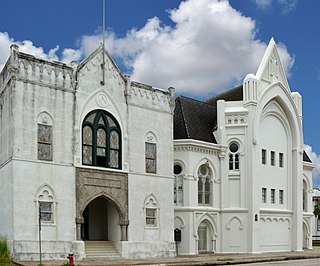
Galveston is a coastal resort city and port off the Southeast Texas coast on Galveston Island and Pelican Island in the U.S. state of Texas. The community of 209.3 square miles (542 km2), with a population of 47,743 in 2010, is the county seat of surrounding Galveston County and second-largest municipality in the county. It is also within the Houston–The Woodlands–Sugar Land metropolitan area at its southern end on the northwestern coast of the Gulf of Mexico.

Galveston County is a county in the U.S. state of Texas, located along the Gulf Coast adjacent to Galveston Bay. As of the 2020 census, the population was 350,682. The county was founded in 1838. The county seat is the City of Galveston, founded the following year of 1839, located on Galveston Island. The most populous municipality in the county is League City, a suburb of Houston at the northern end of the county, which surpassed Galveston in population during the early 2000s.

Galveston Bay is a bay in the western Gulf of Mexico along the upper coast of Texas. It is the seventh-largest estuary in the United States, and the largest of seven major estuaries along the Texas Gulf Coast. It is connected to the Gulf of Mexico and is surrounded by sub-tropical marshes and prairies on the mainland. The water in the bay is a complex mixture of sea water and fresh water, which supports a wide variety of marine life. With a maximum depth of about 10 feet (3 m) and an average depth of only 6 feet (2 m), it is unusually shallow for its size.

Galveston Island is a barrier island on the Texas Gulf Coast in the United States, about 50 miles (80.5 km) southeast of Houston. The entire island, with the exception of Jamaica Beach, is within the city limits of the City of Galveston in Galveston County.

Swinburne Island is a 4-acre (1.6 ha) artificial island in Lower New York Bay, east of Staten Island in New York City. It was used for quarantine of immigrants. Swinburne Island is the smaller of two nearby islands, the other being Hoffman Island to the north.

House Island is a private island in Portland Harbor in Casco Bay, Maine, United States. It is part of the City of Portland. The island is accessible only by boat. Public access is prohibited, except for an on-request tour sanctioned by the island's owners. House Island includes three buildings on the east side and Fort Scammell on the west side. The buildings are used as vacation rentals and other summer residences. The island's name derives from the site of an early European house, believed that built by Capt. Christopher Levett, an English explorer of the region.

The Houston Ship Channel, in Houston, Texas, is part of the Port of Houston, one of the busiest seaports in the world. The channel is the conduit for ocean-going vessels between Houston-area terminals and the Gulf of Mexico, and it serves an increasing volume of inland barge traffic.

Congregation B'nai Israel is a Jewish synagogue located in Galveston, Texas, USA. Organized by German Jewish immigrants in 1868, it is the oldest Jewish Reform congregation and the second chartered Jewish congregation in the state.

The Port of Galveston is the port of the city of Galveston, Texas. It was established by a proclamation issued by the Congress of Mexico on October 17, 1825, while the land known today as Texas was still part of Mexico. The Port of Galveston is the oldest port in the Gulf of Mexico west of New Orleans.

Henry Cohen was a British-American rabbi, scholar, community activist and writer who served most of his career at Congregation B'nai Israel in Galveston, Texas, from 1888 to 1949. He came to the United States in 1885, during a period of rapid and massive growth related to early 20th-century immigration from eastern and southern Europe. In Texas, he organized the Galveston Movement, which worked from 1907 to 1914 to attract eastern European Jewish immigrants to Galveston and the Gulf Coast as a destination, as an alternative to the better known Northeastern cities. Ten thousand such immigrants entered at Galveston.

Jews have inhabited the city of Galveston, Texas, for almost two centuries. The first known Jewish immigrant to the Galveston area was Jao de la Porta, who, along with his brother Morin, financed the first settlement by Europeans on Galveston Island in 1816. de la Porta was born in Portugal of Jewish parentage and later became a Jewish Texan trader. In 1818, Jean Laffite appointed de la Porta supercargo for the Karankawa Indian trade. When Laffite left Galveston Island in 1820, de la Porta became a full-time trader.

Texas Gulf Coast is an intertidal zone which borders the coastal region of South Texas, Southeast Texas, and the Texas Coastal Bend. The Texas coastal geography boundaries the Gulf of Mexico encompassing a geographical distance relative bearing at 367 miles (591 km) of coastline according to CRS and 3,359 miles (5,406 km) of shoreline according to NOAA.

The Free State of Galveston was a whimsical name given to the coastal city of Galveston in the U.S. state of Texas during the early-to-mid-20th century. Today, the term is sometimes used to describe the culture and history of that era.

The history of Galveston, Texas, begins with the archaeological record of Native Americans who used the island. The first European settlements on the island were constructed around 1816. The Port of Galveston was established in 1825 by the Congress of Mexico following its successful revolution from Spain. The city served as the main port for the Texas Navy during the Texas Revolution. Galveston was founded in 1836 by Michel Menard, Samuel May Williams, and Thomas F. McKinney, and briefly served as the capital of the Republic of Texas. The Battle of Galveston was fought in Galveston Bay during the American Civil War when Confederate forces under Major General John B. Magruder attacked and expelled occupying Union troops from the city.

For a period of over 7000 years, humans have inhabited the Galveston Bay Area in what is now the United States. Through their history the communities in the region have been influenced by the once competing sister cities of Houston and Galveston, but still have their own distinct history. Though never truly a single, unified community, the histories of the Bay Area communities have had many common threads.

The Texas oil boom, sometimes called the gusher age, was a period of dramatic change and economic growth in the U.S. state of Texas during the early 20th century that began with the discovery of a large petroleum reserve near Beaumont, Texas. The find was unprecedented in its size (worldwide) and ushered in an age of rapid regional development and industrialization that has few parallels in U.S. history. Texas quickly became one of the leading oil-producing states in the U.S., along with Oklahoma and California; soon the nation overtook the Russian Empire as the top producer of petroleum. By 1940 Texas had come to dominate U.S. production. Some historians even define the beginning of the world's Oil Age as the beginning of this era in Texas.

West Bay, also referred to as West Galveston Bay, is a long inlet of Galveston Bay in Galveston and Brazoria counties that nearly runs the entire length west of Galveston Island.

The Galveston Movement, also known as the Galveston Plan, was a U.S. immigration assistance program operated by several Jewish organizations between 1907 and 1914. The program diverted Jewish immigrants, fleeing Russia and eastern Europe, away from East Coast cities, particularly New York. During its operation, ten thousand Jewish immigrants passed through the port of Galveston, Texas, about a third the number that emigrated to Palestine during the same period. New York financier and philanthropist Jacob Schiff was the driving force behind the effort, which he supported with nearly $500,000 of his personal fortune. B'nai Israel's Rabbi Henry Cohen was the humanitarian face of the movement, meeting ships at the Galveston docks and helping guide the immigrants through the cumbersome arrival and distribution process, and on into the countryside.
Alexander Calvit (1784–1836) was an early settler in colonial Texas and a sugar planter. His Evergreen Plantation lay where the town of Clute, Texas, was later built.

The Columbia River Quarantine Station, now known as the Knappton Cove Heritage Center, is a historic site in Knappton, Washington. The station provided fumigation and quarantine services to maritime vessels at the port on the Columbia River from 1899 to 1938, and is the sole remaining quarantine station on the West Coast of the United States as all others were burned for fear of contamination. It was added to the National Register of Historic Places in 1980.

















